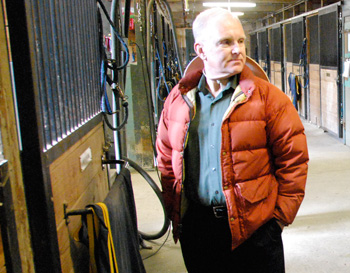
Bert Rances practices casting at the Golden Gate Park casting pools.
Photo by Stephen Smith

Relics in San Francisco
There's no place quite like Golden Gate Park on a perfect spring day. The azaleas are blooming, wind blows through the eucalyptus trees, and a couple of guys are working on their fly-casting skills at the casting pools.
The casting pools are three large, square cement pools, with grids painted on the bottom. Here and there, hoops float on the surface.
"Those are for accuracy casting," says Bert Rances. He swooshes his long pole through the air and gracefully drops his fly onto the water.
Rances is a member of the Golden Gate Angling and Casting Club. He's giving some pointers to his friend, Nick Curcione.
Curcione, who's written a number of books about fly fishing, says Rances is one of the best casters in the country, and this is one of the best places in the country to practice the art of casting. He compares it to playing at Carnegie Hall.
And the casting pools are free, and open to the public.
"I'm here almost five days a week," Curcione says. "There's no place you can do something like this. I mean you can't hit a bucket of golf balls for free."
The ponds and the anglers' lodge that overlooks them are run by the city of San Francisco. They were built by the Works Progress Administration in 1938.

The Angler's Lodge and the casting pools were built by the WPA.
Photo by Stephen Smith
The lodge is a gem among WPA structures. It's small, but it's beautifully crafted. One window glitters with stained glass in the shape of a fishing fly. The shutters have cutouts of leaping trout, and trout are embossed in the concrete floor.
"Everything is handmade," says Gray Brechin as he looks around the lodge. Brechin is a historical geographer based at the University of California Berkeley. He says things are handmade for a reason.
"The idea of that was to give as many people jobs as possible and to train them on the job too. But the main thing is to give people self-respect. There's enormous emphasis on the dignity of labor."
Brechin is an expert on the New Deal structures in this area. He's working on a project to try to inventory and map relics of the Roosevelt administration. It's called California's Living New Deal Project, and it's turned out to be an enormous undertaking. Brechin doubts he'll ever find all the structures the New Deal left behind.
The various New Deal agencies that built things, such as the WPA, the PWA, and the CCC, didn't leave complete and detailed records. And usually the structures they left behind don't have signs or plaques to say who built them.
"I knew these casting pools were here in Golden Gate Park," Brechin says. "I'd found them walking through the park. Most people aren't aware that they're here. They're kind of back in the trees. And then when I was starting to do research on the project I was back at the National Archives in Washington, going through the photographs of WPA work, and lo and behold there was a photograph of the casting pools and the lodge."
Brechin says that discovery led him to other structures in the park.
"The WPA, as in pretty much every park system in country, improved all of Golden Gate Park," he says. "In fact they worked in every park in San Francisco. There are relics all around us that we just don't see."
A short walk from the casting pools is another WPA relic, the police stables. They're still in use, too. A dozen stalls house big, sturdy horses, mostly used for ceremonial occasions now.

Gray Brechin walks through the police stables, another WPA structure in Golden Gate Park.
Photo by Stephen Smith
Next door are the crumbling remnants of another stable built by the WPA. This equestrian center was meant for the public, but it's fallen into disrepair.
Brechin says the public stables and the casting pools were "all part of democratizing sports that had previously been only available for the elites. This is what WPA and the CCC did. They built facilities for everybody."
The WPA also provided jobs for millions of people. Much of it was unskilled labor, but some was highly skilled, and some WPA projects were meant to employ artists.
The Beach Chalet in Golden Gate Park wasn't built by a New Deal agency, but the WPA added elaborate murals to its first floor. The huge paintings depict life in San Francisco in the 1930s. There are people strolling in the park. There's an iceman delivering ice on a dolly in front of the Bay Bridge. The bridge had just been built by the PWA when the murals were painted.
The California Living New Deal Project plots New Deal relics such as the murals and the casting pools on an online map. The map of the Bay Area bristles with so many virtual pins that it's hard to see what's what until you zoom in. Zoom to Golden Gate Park, and you discover that, among other things, New Deal workers built the Model Yacht Club, the horseshoe pits and the tennis courts. They remodeled the DeYoung Museum, the California Academy of Sciences, and Kezar Stadium.
Zoom out, and there are hundreds of other sites throughout San Francisco and the rest of the state.
The process of inventorying New Deal sites in California is still not finished, but Brechin hopes eventually the project can be even bigger. "We hope to make that a national inventory," he says, "involving thousands of people in uncovering what I call the lost civilization of the New Deal."
Back to WPA, or return to Bridge to Somewhere.
